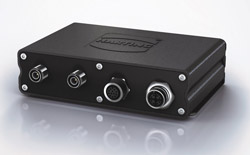
Posted to News on 17th Oct 2017, 19:38
Using MICA to implement the Industry 4.0 reference architecture
Gavin Stopple of Harting Ltd explains how the Harting MICA platform can be used to implement RAMI 4.0, the Reference Architecture for Industry 4.0.

In future, industrial manufacturing will be simpler and more modular. Both of these trends result from the adoption of concepts like Integrated Industry and Industry 4.0, the equivalent of the Industrial Internet of Things (IIoT).
Compact and robust systems will have to be developed to implement distributed task assignment in the field. These tasks might include the acquisition of sensor data or data from communications with central IT systems. These scenarios are highly suitable for Harting's MICA (Modular Industry Computing Architecture).
Open platform
MICA (see image above) is a modular and open platform for the fast and cost-efficient implementation of individual Integrated Industry projects. The MICA platform consists of a toolbox for hardware modules and software applications that offers the ability to provide rapid prototyping and application development. In contrast to single-board computers such as Beaglebone or Raspberry Pi, MICA features a three-part board, one part of which can be customised.
Another advantage is its suitability for industrial use, down to the smallest of details: the MICA is robust and comes in a compact aluminium housing, including industry-standard connectors. Even with hardware adaptations, the form factor and the degree of protection remain constant.
The modular concept has served as the basis on which different MICA versions have already been implemented by Harting and within the Harting partner network. These include:
- MICA Energy for capturing energy data via a Modbus interface
- MICA as an RFID reader with integrated data processing capabilities
- MICA variants with fieldbus connectivity for EtherCAT, Profinet and Ethernet/IP applications
- MICA as a gateway to LoRaWAN (Long Range Wide Area Network) networks
MICA and RAMI 4.0
MICA assumes a key function when the initial step is taken on the way to Industry 4.0, namely the digitalisation of production equipment. First, this move means that the MICA is linked to the Reference Architecture Model of Industry 4.0, or RAMI 4.0 for short, which was jointly defined by the German business associations BITKOM, VDMA, ZVEI and other partners.
Essential elements of Industry 4.0 are brought together by RAMI 4.0 in a three-dimensional co-ordinate system that features a layered structure. The goal is to use a service-oriented architecture to aid in abiding by a common understanding of standards, Industry 4.0 technology and different user perspectives.
RAMI 4.0 recommends using the concept of a 'management shell' to create the virtual image of a device or a machine in the digital world. MICA is an hardware basis for this: it makes devices usable that were previously not even networked, or which possess outdated communications capabilities. In the virtual world, MICA helps to transform old machines into new, modern devices, as shown by the following examples from Harting's own production plants.
Retrofitting production equipment

A retrofit example can be found in an injection moulding machine used in Harting's connector manufacturing line (see right). Here, the MICA bridges the gap between the injection moulding machine and the ERP/MES by implementing the RAMI 4.0 management shell. It also implements the necessary protocol conversion between the legacy Euromap 15 protocol and modern communication systems such as MQTT or OPC UA. In the other direction, it handles the conversion back to byte sequences and communicates with the machine in accordance with the protocol.
In another application example, injection moulding machines of various manufacturers and ages at a Harting factory are connected to IBM Bluemix and Watson IIoT systems using MICA, which acts as an administration shell, creating a digital representation of a device in the digital world, thereby transforming it into an Industry 4.0 component. The MICA computers are equipped with a modular function board that provides Modbus RTU and 8_S0 connections for current transformers and current meters. At the same time, the MICA records the RFID tags of the installed injection moulding tools via Ethernet.
All data is then optionally stored locally on the MICA in Influx DB - which is an open source database optimised for time series - using the freely available MICA MQTT container and evaluated using the open source tool Grafana, or transferred to an IBM data centre in for storage and evaluation via a Watson IIoT connector installed on the MICA.
Follow the link for more information about Harting's MICA platform for Industry 4.0 applications: www.harting.co.uk/mica.
Want the latest machine building news straight to your inbox? Become a MachineBuilding member for free today >>

















